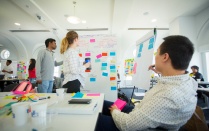Architecture Students Explore Housing Solutions for Refugees in Northern Uganda
South Sudan, the world’s newest country, has experienced international and domestic conflicts since its secession from the Republic of Sudan in 2011. Fighting beginning in early July 2016 forced hundreds of thousands of people to flee to Kenya, Sudan, and other regions within South Sudan, but primarily Uganda. The number of refugees entering Uganda increased from averages of about 200 per day the first half of the year to thousands per day starting in July, including more than 8,000 on July 21. Throughout September 2016, an average of 2,829 South Sudanese refugees crossed into Uganda each day; during a similar period, refugee settlements in the Adjumani region saw an influx of nearly 1,000 refugees per day. It is now the world’s largest refugee resettlement area. As of the end of 2016, Uganda hosted more than 600,000 refugees from South Sudan alone, adding to refugees in recent decades fleeing violence and other insecurities from Rwanda, Burundi, the Democratic Republic of the Congo, and other countries.
The Danish Refugee Council (DRC), a global leader in refugee resettlement that works in more than 30 countries, is coordinating resettlement in the region.
The influx has placed a strain on refugee collection-, transit-, and reception centers, as sleeping quarters, latrines, food stocks, and health clinics approached breakpoints. Decongestion of such centers, i.e., rapid resettlement of new arrivals, became exceedingly urgent during the latter half of 2016 and early 2017, and remains a challenge. Meeting UNHCR guidelines for housing is a major challenge, while also incorporating cultural needs and preferences, and delivering on tight timelines and low budgets.
In response to these needs and conversations with DRC leadership, senior architecture students in the School of Architecture and Planning at the University at Buffalo, working with Professor Korydon Smith, took on this global challenge in the spring of 2017. Below is a sample of their work, which both frames the challenges of refugee resettlement and explores solutions for housing amidst the complex situation in Uganda.
Though not well known, “Uganda has one of the most favourable refugee protection environments in the world—providing for freedom of movement, right to work, and…land for refugee settlements.”
- UNHCR, Uganda country website
























